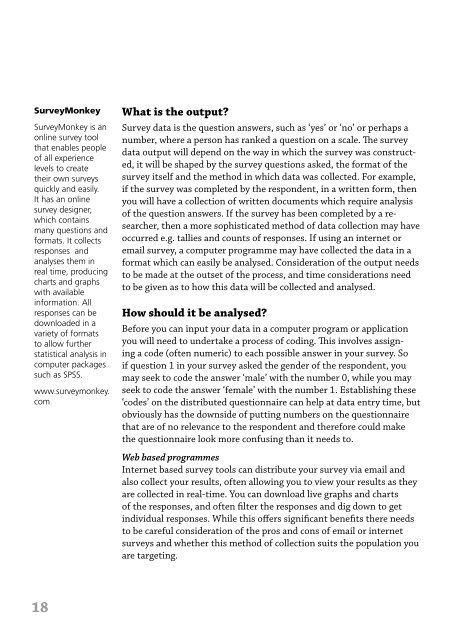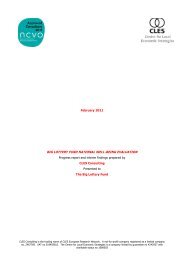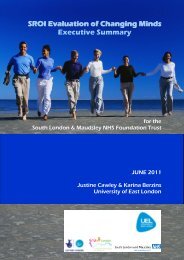Research Methods Handbook.pdf - CLES
Research Methods Handbook.pdf - CLES
Research Methods Handbook.pdf - CLES
You also want an ePaper? Increase the reach of your titles
YUMPU automatically turns print PDFs into web optimized ePapers that Google loves.
SurveyMonkeySurveyMonkey is anonline survey toolthat enables peopleof all experiencelevels to createtheir own surveysquickly and easily.It has an onlinesurvey designer,which containsmany questions andformats. It collectsresponses andanalyses them inreal time, producingcharts and graphswith availableinformation. Allresponses can bedownloaded in avariety of formatsto allow furtherstatistical analysis incomputer packagessuch as SPSS.www.surveymonkey.comWhat is the output?Survey data is the question answers, such as ‘yes’ or ‘no’ or perhaps anumber, where a person has ranked a question on a scale. The surveydata output will depend on the way in which the survey was constructed,it will be shaped by the survey questions asked, the format of thesurvey itself and the method in which data was collected. For example,if the survey was completed by the respondent, in a written form, thenyou will have a collection of written documents which require analysisof the question answers. If the survey has been completed by a researcher,then a more sophisticated method of data collection may haveoccurred e.g. tallies and counts of responses. If using an internet oremail survey, a computer programme may have collected the data in aformat which can easily be analysed. Consideration of the output needsto be made at the outset of the process, and time considerations needto be given as to how this data will be collected and analysed.How should it be analysed?Before you can input your data in a computer program or applicationyou will need to undertake a process of coding. This involves assigninga code (often numeric) to each possible answer in your survey. Soif question 1 in your survey asked the gender of the respondent, youmay seek to code the answer ‘male’ with the number 0, while you mayseek to code the answer ‘female’ with the number 1. Establishing these‘codes’ on the distributed questionnaire can help at data entry time, butobviously has the downside of putting numbers on the questionnairethat are of no relevance to the respondent and therefore could makethe questionnaire look more confusing than it needs to.Web based programmesInternet based survey tools can distribute your survey via email andalso collect your results, often allowing you to view your results as theyare collected in real-time. You can download live graphs and chartsof the responses, and often filter the responses and dig down to getindividual responses. While this offers significant benefits there needsto be careful consideration of the pros and cons of email or internetsurveys and whether this method of collection suits the population youare targeting.ExcelMicrosoft Excel is useful for data summary, presentation, and for otherbasic statistical analysis. The program provides a set of data analysistools called the Analysis ToolPak which you can use to save steps whenyou develop complex statistical analyses. You provide the data and parametersfor each analysis and the tool uses the appropriate statisticalmacro functions and then displays the results in an output table. Sometools generate charts in addition to output tables. The Analysis ToolPakis not loaded by default, instructions for installing it, along with guideson how to use it can be found on the Microsoft website.SPSS (Statistical Package for Social Scientists)SPSS is among the most widely used program for statistical analysis insocial science. This is a data analysis package for quantitative research.It is particularly useful for the analysis of survey data as it covers abroad range of statistical procedures. There are other packages availablesuch as SAS, Stata or Minitab however all are expensive to purchase,especially if only to be used for a one off survey. It may be possible towork with an academic institution to utilise their statistical packages,and organisations such as the Cathie Marsh Centre for Census and Survey<strong>Research</strong> (CCSR) provide training on the use of these packages.For more detail on data analysis see section on Statistical Analysis.Further readingA practical guide to sampling, National Audit Officehttp://www.nao.org.uk/publications/Samplingguide.<strong>pdf</strong>Question Bank is an information resource, in the field of social research,with a particular emphasis on quantitative survey methods.http://qb.soc.surrey.ac.uk/A general introduction to the design of questionnaires for surveyresearch, University of Leedshttp://www.leeds.ac.uk/iss/documentation/top/top2.<strong>pdf</strong>The Centre for Applied Social Surveys, University of Southampton– runs a programme of short courses in survey methods across the UK.http://www.s3ri.soton.ac.uk/cass/programme.php18 19









